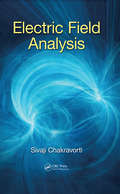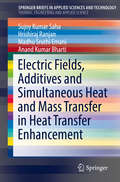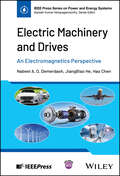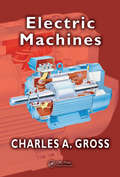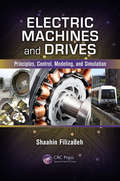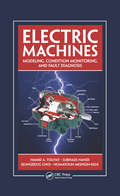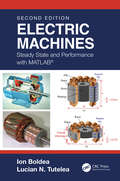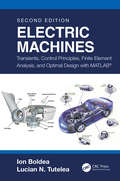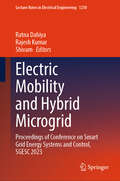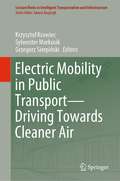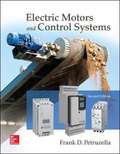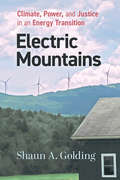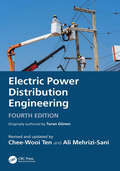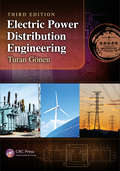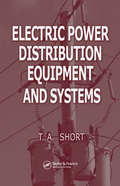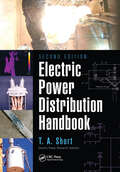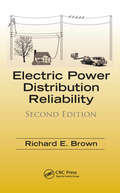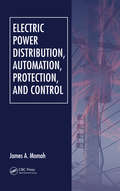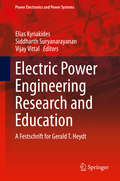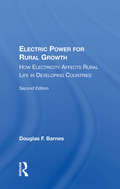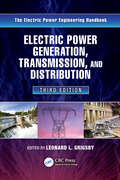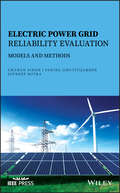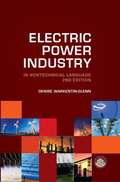- Table View
- List View
Electric Field Analysis
by Sivaji ChakravortiElectric Field Analysis is both a student-friendly textbook and a valuable tool for engineers and physicists engaged in the design work of high-voltage insulation systems. The text begins by introducing the physical and mathematical fundamentals of electric fields, presenting problems from power and dielectric engineering to show how the theories are put into practice. The book then describes various techniques for electric field analysis and their significance in the validation of numerically computed results, as well as: <P><P>Discusses finite difference, finite element, charge simulation, and surface charge simulation methods for the numerical computation of electric fields Provides case studies for electric field distribution in a cable termination, around a post insulator, in a condenser bushing, and around a gas-insulated substation (GIS) spacer Explores numerical field calculation for electric field optimization, demonstrating contour correction and examining the application of artificial neural networks Explains how high-voltage field optimization studies are carried out to meet the desired engineering needs Electric Field Analysis is accompanied by an easy-to-use yet comprehensive software for electric field computation. The software, along with a wealth of supporting content, is available for download with qualifying course adoption.
Electric Fields in Composite Dielectrics and their Applications
by Tadasu Takuma Boonchai TechaumnatAn accurate quantitative picture of electric field distribution is essential in many electrical and electronic applications. In composite dielectric configurations composed of multiple dielectrics, anomalous or unexpected behavior of electric fields may appear when a solid dielectric is in contact with a conductor or another solid dielectric. The electric field near the contact point may become higher than the original field not only in the surrounding medium but also in the solid dielectric. Theoretically it may become infinitely high, depending on the contact angle. Although these characteristics are very important in a variety of applications, they have been clarified only recently using analytical and numerical calculation methods, and this is the first book to cover these new findings. Electric Fields in Composite Dielectrics and Their Applications describes the fundamental characteristics and practical applications of electric fields in composite dielectrics. The focus is on the field distribution (and the resultant force when appropriate) near points of contact. Applications include insulation design of high-voltage equipment with solid insulating supports, utilization of electrostatic force on dielectric particles in electrophotography and electrorheological fluids, and others. Electric Fields in Composite Dielectrics and Their Applications also explains the calculation methods used to analyze electric fields in composite dielectrics.
Electric Fields, Additives and Simultaneous Heat and Mass Transfer in Heat Transfer Enhancement (SpringerBriefs in Applied Sciences and Technology)
by Sujoy Kumar Saha Hrishiraj Ranjan Madhu Sruthi Emani Anand Kumar BhartiThis Brief deals with electrode design and placement, enhancement of both liquid and gas flow, vapor space condensation, in-tube condensation, falling film evaporation, correlations. It further provides a fundamental understanding of boiling and condensation, pool boiling, critical heat flux, convective vaporization, additives for single-phase liquids like solid particles, gas bubbles, suspensions in dilute polymer and surfactant solutions, solid additives and liquid additives for gases, additives for boiling, condensation and absorption, mass transfer resistance in gas phase (condensation with noncondensible gases, evaporation into air, dehumidifying finned tube heat exchangers, water film enhancement of finned tube exchanger), controlling resistance in liquid phase, and significant resistance in both phases. The volume is ideal for professionals and researchers dealing with thermal management in devices.
Electric Machinery and Drives: An Electromagnetics Perspective (IEEE Press Series on Power and Energy Systems)
by Hao Chen Nabeel A. Demerdash JiangBiao HeComprehensive resource on the fundamentals of electric machinery and variable speed drives, and their many conventional and emerging applications Electric Machinery and Drives: An Electromagnetics Perspective provides advanced concepts of electrical machinery with control/drives and emphasizes the necessity of integration of power electronics and control strategy when studying modern electrical machinery. The text incorporates the fundamentals of electric machinery, variable speed drives, and motor controls, with the scope of including both the introduction of detailed operating principles as well as the electromagnetic design and control details from scratch. The authors start with the introduction of electric circuit notations and elementary concepts of electrical circuits, power electronics, magnetostatics, magnetic circuits, and fundamentals of electromechanical energy conversion. Later, the book elaborates on the operating principles of polyphase induction machines and synchronous machines, as well as the associated scale and vector controls of these machines. To aid in reader comprehension, the text includes a solutions manual and accompanying video animations. Electric Machinery and Drives also contains information on: Real and reactive power in single-phase and balanced three-phase circuits and devices using consumer system concepts and notationsForces and torques in simple magnetically linear and nonlinear, multi-excited electromechanical devices and systemsSimplified T-equivalent circuit model and its use in performance calculations of induction machines and associated torque-slip (speed) characteristicsBrush-commutator and brushless DC machines, and natural ABC frame and Park’s two-reaction DQO frame state-space modeling of synchronous and induction machinesSpecial machines, including single-phase induction machines, switched reluctance machines, and others Electric Machinery and Drives is an ideal learning resource in undergraduate or graduate-level courses for all universities with electrical engineering programs across the world. Additionally, the text may be used as a fundamental reference by researchers and engineers in electrical, mechanical, automotive, aerospace, and automation engineering.
Electric Machines (Electric Power Engineering Series)
by Charles A. GrossThe two major broad applications of electrical energy are information processing and energy processing. Hence, it is no wonder that electric machines have occupied a large and revered space in the field of electrical engineering. Such an important topic requires a careful approach, and Charles A. Gross' Electric Machines offers the most balanced, a
Electric Machines and Drives: Principles, Control, Modeling, and Simulation
by Shaahin FilizadehElectric machines have a ubiquitous presence in our modern daily lives, from the generators that supply electricity to motors of all sizes that power countless applications. Providing a balanced treatment of the subject, Electric Machines and Drives: Principles, Control, Modeling, and Simulation takes a ground-up approach that emphasizes fundamental principles. The author carefully deploys physical insight, mathematical rigor, and computer simulation to clearly and effectively present electric machines and drive systems. Detailing the fundamental principles that govern electric machines and drives systems, this book: Describes the laws of induction and interaction and demonstrates their fundamental roles with numerous examples Explores dc machines and their principles of operation Discusses a simple dynamic model used to develop speed and torque control strategies Presents modeling, steady state based drives, and high-performance drives for induction machines, highlighting the underlying physics of the machine Includes coverage of modeling and high performance control of permanent magnet synchronous machines Highlights the elements of power electronics used in electric drive systems Examines simulation-based optimal design and numerical simulation of dynamical systems Suitable for a one semester class at the senior undergraduate or a graduate level, the text supplies simulation cases that can be used as a base and can be supplemented through simulation assignments and small projects. It includes end-of-chapter problems designed to pick up on the points presented in chapters and develop them further or introduce additional aspects. The book provides an understanding of the fundamental laws of physics upon which electric machines operate, allowing students to master the mathematical skills that their modeling and analysis requires.
Electric Machines: Modeling, Condition Monitoring, and Fault Diagnosis
by Hamid A. Toliyat Subhasis Nandi Seungdeog Choi Homayoun Meshgin-KelkWith countless electric motors being used in daily life, in everything from transportation and medical treatment to military operation and communication, unexpected failures can lead to the loss of valuable human life or a costly standstill in industry. To prevent this, it is important to precisely detect or continuously monitor the working condition of a motor. Electric Machines: Modeling, Condition Monitoring, and Fault Diagnosis reviews diagnosis technologies and provides an application guide for readers who want to research, develop, and implement a more effective fault diagnosis and condition monitoring scheme—thus improving safety and reliability in electric motor operation. It also supplies a solid foundation in the fundamentals of fault cause and effect. Combines Theoretical Analysis and Practical Application Written by experts in electrical engineering, the book approaches the fault diagnosis of electrical motors through the process of theoretical analysis and practical application. It begins by explaining how to analyze the fundamentals of machine failure using the winding functions method, the magnetic equivalent circuit method, and finite element analysis. It then examines how to implement fault diagnosis using techniques such as the motor current signature analysis (MCSA) method, frequency domain method, model-based techniques, and a pattern recognition scheme. Emphasizing the MCSA implementation method, the authors discuss robust signal processing techniques and the implementation of reference-frame-theory-based fault diagnosis for hybrid vehicles. Fault Modeling, Diagnosis, and Implementation in One Volume Based on years of research and development at the Electrical Machines & Power Electronics (EMPE) Laboratory at Texas A&M University, this book describes practical analysis and implementation strategies that readers can use in their work. It brings together, in one volume, the fundamentals of motor fault conditions, advanced fault modeling theory, fault diagnosis techniques, and low-cost DSP-based fault diagnosis implementation strategies.
Electric Machines: Steady State and Performance with MATLAB®
by Ion Boldea Lucian N. TuteleaWith its comprehensive coverage of the state of the art, this Second Edition introduces basic types of transformers and electric machines. Classifications and characterization—modeling and performance—of power electric transformers (single and multiphase), motors and generators, commercial machines (dc brush, induction dc excited synchronous, PM synchronous, reluctance synchronous) and some new ones (multiphase ac machines, switched reluctance machines) with great potential for industry with rotary or linear motion are all treated in the book. The book covers, in detail, circuit modeling characteristics and performance characteristics under steady state, testing techniques and preliminary electromagnetic-thermic dimensioning with lots of solved numerical examples and special cases to illustrate new electric machines with strong industrialization potential. All formulae used to characterize parameters and performance may be safely used in industry for preliminary designs and have been applied in the book through numerical solved examples of industrial interest. Numerous computer simulation programs in MATLAB® and Simulink® that illustrate performance characteristics present in the chapters are included and many be used as homework to facilitate a deeper understanding of fundamental issues. This book is intended for a first-semester course covering electric transformers, rotary and linear machines, steady-state modeling and performance computation, preliminary dimensioning, and testing standardized and innovative techniques. The textbook may be used by R&D engineers in industry as all machine parameters and characteristics are calculated by ready-to-use industrial design mathematical expressions.
Electric Machines: Transients, Control Principles, Finite Element Analysis, and Optimal Design with MATLAB®
by Ion Boldea Lucian N. TuteleaThis Second Edition extensively covers advanced issues/subjects in electric machines, starting from principles, to applications and case studies with ample graphical (numerical) results. This textbook is intended for second (and third) semester courses covering topics such as modeling of transients, control principles, electromagnetic and thermal finite element analysis, and optimal design (dimensioning). Notable recent knowledge with strong industrialization potential has been added to this edition, such as: Orthogonal models of multiphase a.c. machines Thermal Finite Element Analysis of (FEA) electric machines FEA–based–only optimal design of a PM motor case study Line start synchronizing premium efficiency PM induction machines Induction machines (three and single phase), synchronous machines with DC excitation, with PM-excitation, and with magnetically salient rotor and a linear Pm oscillatory motor are all investigated in terms of transients, electromagnetic FEM analysis and control principles. Case studies, numerical examples, and lots of discussion of FEM results for PMSM and IM are included throughout the book. The optimal design is treated in detail using Hooke–Jeeves and GA algorithms with case comparison studies in dedicated chapters for IM and PMSM. Numerous computer simulation programs in MATLAB® and Simulink® are available online that illustrate performance characteristics present in the chapters, and the FEM and optimal design case studies (and codes) may be used as homework to facilitate a deeper understanding of fundamental issues.
Electric Mobility and Hybrid Microgrid: Proceedings of Conference on Smart Grid Energy Systems and Control, SGESC 2023 (Lecture Notes in Electrical Engineering #1230)
by Rajesh Kumar Ratna Dahiya ShivamThe book contains selected proceedings from the International Conference on Smart Grid Energy Systems and Control (SGESC 2023). It is divided into 2 volumes and focuses on Electric Mobility and Hybrid Microgrid. The topics covered include power electronics for hybrid and electric vehicles, wireless power transfer, renewable power generation, energy storage, and challenges in grid integration of microgrids. This book is a valuable resource for academic researchers and industry practitioners.
Electric Mobility in Public Transport—Driving Towards Cleaner Air (Lecture Notes in Intelligent Transportation and Infrastructure)
by Grzegorz Sierpiński Krzysztof Krawiec Sylwester MarkusikThis book addresses various aspects of electric mobility deployment in public transport. These include transport policy-related issues as well as technical, organizational and technical dimensions of the fleet conversion process (from conventional one towards the increased share of electric vehicles in public transport). In the book, one may find, e.g. the determinants for the successful functioning of electrified transport systems (including charging facilities), models and methods for battery electric bus energy consumption, the analysis regarding the charging strategies (including power-grid) as well as electric vehicle battery issues. As the process of fleet conversion is multi-faceted, the book also contains the issues related to cybersecurity in public transport, autonomous vehicles and hyperloop. The book is dedicated to transport professionals, consulting companies and researchers in the field of electromobility and modern transport systems.
Electric Motors and Control Systems
by Frank D. PetruzellaThis book has been written for a course of study that will introduce the reader to a broad range of motor types and control systems. It provides an overview of electric motor operation, selection, installation, control and maintenance. Every effort has been made in this second edition to present the most up-to-date information which reflects the current needs of the industry. The broad based approach taken makes this text viable for a variety of motors and control systems courses. Content is suitable for colleges, technical institutions, vocational/technical schools as well as apprenticeship and journeymen training. Electrical apprentices and journeymen will find this book to be invaluable due to Electrical Code references applicable to the installation of new control systems and motors, as well as information on maintenance and troubleshooting techniques. Personnel involved in the motor maintenance and repair will find this book to be a useful reference text. The text is comprehensive! It includes coverage of how motors operate in conjunction with their associated control circuitry. Both older and newer motor technologies are examined. Topics covered range from motor types and controls to installing and maintaining conventional controllers, electronic motor drives and programmable logic controllers. Also Available! Activities Manual for Electric Motors and Control Systems, as well as, McGraw-Hill Education's Connect! Connect is the only integrated learning system that empowers students by continuously adapting to deliver precisely what they need, when they need it, and how they need it, so that your class time is more engaging and effective. SAVE WHEN YOU BUY A PACKAGE!Electric Motors & Control Systems 2/e Textbook + Activities Manual ISBN: 1259332837 WILL BE AVAILABLE FEBRUARY 2015
Electric Mountains: Climate, Power, and Justice in an Energy Transition (Nature, Society, and Culture)
by Shaun A. GoldingClimate change has shifted from future menace to current event. As eco-conscious electricity consumers, we want to do our part in weening from fossil fuels, but what are we actually a part of? Committed environmentalists in one of North America’s most progressive regions desperately wanted energy policies that address the climate crisis. For many of them, wind turbines on Northern New England’s iconic ridgelines symbolize the energy transition that they have long hoped to see. For others, however, ridgeline wind takes on a very different meaning. When weighing its costs and benefits locally and globally, some wind opponents now see the graceful structures as symbols of corrupted energy politics. This book derives from several years of research to make sense of how wind turbines have so starkly split a community of environmentalists, as well as several communities. In doing so, it casts a critical light on the roadmap for energy transition that Northern New England’s ridgeline wind projects demarcate. It outlines how ridgeline wind conforms to antiquated social structures propping up corporate energy interests, to the detriment of the swift de-carbonizing and equitable transformation that climate predictions warrant. It suggests, therefore, that the energy transition of which most of us are a part, is probably not the transition we would have designed ourselves, if we had been asked.
Electric Noir: Three Thrillers: The Night Market, The Poison Artist, The Dark Room
by Jonathan MooreThe &“suspense that never stops&” in this thriller trilogy set in San Francisco by the Edgar Award and Hammett Prize–nominated author (James Patterson).The Poison Artist After a fleeting encounter with a seductive woman, toxicologist Caleb Maddox becomes obsessed with finding her again. Meanwhile, he begins helping with a serial-murder investigation. Soon the search for the killer entwines with Caleb&’s hunt for the woman in &“a wicked mix of Poe, The Silence of the Lambs, and Vertigo&” (William Landay).The Dark Room Homicide inspector Gavin Cain is called in for a highly sensitive case: the mayor is being blackmailed. A series of photographs show a beautiful woman shackled to a bed. And worse revelations are to come if the mayor doesn&’t take his own life first. This &“electrifying noir thriller&” tracks Cain as he enters a web of deceit and destruction (Booklist, starred review).The Night Market In this &“sharp and scary near-future thriller,&” Inspector Ross Carver is at a crime scene where a dead man is covered in an unknown substance eating through his skin. Suddenly, he&’s hauled into a trailer and shocked unconscious. When he wakes up days later, he&’s in his own bed, lying next to his neighbor Mia—a woman he barely knows. And she knows a lot more than she&’s letting on (Publishers Weekly, starred review).
Electric Power Distribution Engineering
by Chee-Wooi Ten Ali Mehrizi-SaniAre you fascinated by the complex web of electrical power that illuminates our modern world? Do you want to understand the intricate systems responsible for delivering electricity to our homes, businesses, and industries? Look no further than Electric Power Distribution System Engineering, Fourth Edition by renowned author Turan Gönen, revised and updated by Chee-Wooi Ten and Ali Mehrizi-Sani. This captivating book takes you on a journey through the fascinating realm of electric power distribution, offering a comprehensive yet accessible exploration of the engineering principles, technologies, and practices that underpin this vital aspect of our daily lives. Whether you're a curious non-specialist, an avid reader with a thirst for knowledge, or a librarian or bookseller seeking an invaluable resource, Gönen's masterwork will both enlighten and captivate you.An early leader in the academic market, this book provides an overview of classical planning for electric power distribution systems, which has been used for many years in designing and analyzing electric power distribution systems. The authors have taken a bold initiative to update the content, incorporating relevant aspects reflecting the advancements of today's evolving smart grid. Within its pages, readers will discover detailed discussions on the principles of power distribution, including the fundamentals of power generation, transmission, and distribution. The authors provide detailed explanations of the various components and equipment used in distribution systems, such as transformers, circuit breakers, switches, and protective devices. As part of the book, planning for the distribution network involves sizing and considering candidate geographical locations/regions in relation to the capacity of existing infrastructure, allowing for new additions to be built. For example, this includes locations either extending another feeder from distribution substations or building new distribution substations, depending on what makes more sense. Many assumptions have been made for non-existing distribution feeders to calculate ballpark figures for determining voltage profile and power losses if they were to be constructed. Readers will gain insights into how these considerations translate into net positive, net negative, or net-zero loads. All of these aspects can be gradually integrated with renewable energy sources, innovative grid technologies, and distribution automation over time.The authors involved in this book have made significant contributions to the state-of-the-art development by incorporating recent updates from the literature, thereby addressing the latest advancements. One remarkable feature of Turan Gönen's Electric Power Distribution System Engineering is its strong focus on practical applications and real-world scenarios. In addition to providing theoretical knowledge, the book also offers numerous examples that effectively bridge the gap between theory and practice. This unique approach enables readers to comprehend the intricacies of distribution system engineering and apply their newfound knowledge to solve complex problems in the field. By seamlessly blending theoretical foundations with practical insights, Gonen's book emerges as an indispensable resource for aspiring engineers, professionals, and researchers, as it offers a comprehensive understanding of electric power distribution systems and their practical implications.
Electric Power Distribution Engineering
by Turan Gönen<p>A quick scan of any bookstore, library, or online bookseller will produce a multitude of books covering power systems. However, few, if any, are totally devoted to power distribution engineering, and none of them are true textbooks. Filling this vacuum in the power system engineering literature, Electric Power Distribution System Engineering broke new ground. <p>Designed specifically for junior- or senior-level electrical engineering courses, the book covers all aspects of distribution engineering from basic system planning and concepts through distribution system protection and reliability. Drawing on decades of experience to provide a text that is as attractive to students as it is useful to professors and practicing engineers, the author demonstrates how to design, analyze, and perform modern distribution system engineering. He takes special care to cover industry terms and symbols, providing a glossary and clearly defining each term when it is introduced. The discussion of distribution planning and design considerations goes beyond the usual analytical and qualitative analysis to emphasize the economical explication and overall impact of the distribution design considerations discussed.</p>
Electric Power Distribution Equipment and Systems
by Thomas Allen ShortPower distribution and quality remain the key challenges facing the electric utilities industry. Choosing the right equipment and architecture for a given application means the difference between success and failure. Comprising chapters carefully selected from the best-selling Electric Power Distribution Handbook, Electric Power Distribution Equipment and Systems provides an economical, sharply focused reference on the technologies and infrastructures that enable reliable, efficient distribution of power, from traversing vast distances to local power delivery.The book works inward from broad coverage of overall power systems all the way down to specific equipment application. It begins by laying a foundation in the fundamentals of distribution systems, explaining configurations, substations, loads, and differences between European and US systems. It also includes a look at the development of the field as well as future problems and challenges to overcome. Building on this groundwork, the author elaborates on both overhead and underground distribution networks, including the underlying concepts and practical issues associated with each. Probing deeper into the system, individual chapters explore transformers, voltage regulation, and capacitor application in detail, from basic principles to operational considerations.With clear explanations and detailed information, Electric Power Distribution Equipment and Systems gathers critical concepts, technologies, and applications into a single source that is ideally suited for immediate implementation.
Electric Power Distribution Handbook
by Thomas Allen ShortOf the "big three" components of electrical infrastructure, distribution typically gets the least attention. In fact, a thorough, up-to-date treatment of the subject hasn’t been published in years, yet deregulation and technical changes have increased the need for better information. Filling this void, the Electric Power Distribution Handbook delivers comprehensive, cutting-edge coverage of the electrical aspects of power distribution systems. The first few chapters of this pragmatic guidebook focus on equipment-oriented information and applications such as choosing transformer connections, sizing and placing capacitors, and setting regulators. The middle portion discusses reliability and power quality, while the end tackles lightning protection, grounding, and safety. The Second Edition of this CHOICE Award winner features: 1 new chapter on overhead line performance and 14 fully revised chapters incorporating updates from several EPRI projects New sections on voltage optimization, arc flash, and contact voltage Full-color illustrations throughout, plus fresh bibliographic references, tables, graphs, methods, and statistics Updates on conductor burndown, fault location, reliability programs, tree contacts, automation, and grounding and personnel protection Access to an author-maintained support website, distributionhandbook.com, with problems sets, resources, and online apps An unparalleled source of tips and solutions for improving performance, the Electric Power Distribution Handbook, Second Edition provides power and utility engineers with the technical information and practical tools they need to understand the applied science of distribution.
Electric Power Distribution Reliability (Power Engineering (Willis))
by Richard E. BrownDue to its high impact on the cost of electricity and its direct correlation with customer satisfaction, distribution reliability continues to be one of the most important topics in the electric power industry. Continuing in the unique tradition of the bestselling first edition, Electric Power Distribution Reliability, Second Edition consolidates all pertinent topics on electric power distribution into one comprehensive volume balancing theory, practical knowledge, and real world applications. Updated and expanded with new information on benchmarking, system hardening, underground conversion, and aging infrastructure, this timely reference enables you to— · Manage aging infrastructure · Harden electric power distribution systems · Avoid common benchmarking pitfalls · Apply effective risk management The electric power industry will continue to make distribution system reliability and customer-level reliability a top priority. Presenting a wealth of useful knowledge, Electric Power Distribution Reliability, Second Edition remains the only book that is completely dedicated to this important topic.
Electric Power Distribution, Automation, Protection, and Control
by James A. Momoh<p>New methods for automation and intelligent systems applications, new trends in telecommunications, and a recent focus on renewable energy are reshaping the educational landscape of today's power engineer. Providing a modern and practical vehicle to help students navigate this dynamic terrain, Electric Power Distribution, Automation, Protection, and Control infuses new directions in computation, automation, and control into classical topics in electric power distribution. <p>Ideal for a one-semester course for senior undergraduates or first-year graduate students, this text works systematically through basic distribution principles, renewable energy sources, computational tools and techniques, reliability, maintenance, distribution automation, and telecommunications. Numerous examples, problems, and case studies offer practical insight into the concepts and help build a working knowledge of protection schemes, fault analysis and synthesis, reliability analysis, intelligent automation systems, distribution management systems, and distribution system communications. The author details different renewable energy sources and teaches students how to evaluate them in terms of size, cost, and performance. <p>Guided firmly by the author's wealth of industrial and academic experience, your students will learn the tools and techniques used to design, build, and operate future generations of distribution systems with unparalleled efficiency, robustness, and sustainability.</p>
Electric Power Engineering Research and Education
by Vijay Vittal Elias Kyriakides Siddharth SuryanarayananThis unique volume covers the most compelling areas of advance in electric power engineering, from distributed generation and dispatch to power quality improvement and energy storage. The authors particularly highlight the seminal contributions of Dr. Gerald T. Heydt in the development and teaching of these technological advances, which have impacted the power industry and academia over the last 4 decades in areas such as transmission and distribution engineering, power engineering education, and centers for power engineering research.
Electric Power For Rural Growth: How Electricity Affects Rural Life In Developing Countries
by Douglas F. BarnesThis book offers important historical information on the state of rural electrification in the 1980s. It also summarizes the development of benefit evaluation methods, along with findings from recent research on the impact of rural electrification for development.
Electric Power Generation, Transmission, and Distribution (Electric Power Engineering Series)
by Leonard L. GrigsbyFeaturing contributions from worldwide leaders in the field, the carefully crafted Electric Power Generation, Transmission, and Distribution, Third Edition (part of the five-volume set, The Electric Power Engineering Handbook) provides convenient access to detailed information on a diverse array of power engineering topics. Updates to nearly every chapter keep this book at the forefront of developments in modern power systems, reflecting international standards, practices, and technologies. Topics covered include: Electric power generation: nonconventional methods Electric power generation: conventional methods Transmission system Distribution systems Electric power utilization Power quality L.L. Grigsby, a respected and accomplished authority in power engineering, and section editors Saifur Rahman, Rama Ramakumar, George Karady, Bill Kersting, Andrew Hanson, and Mark Halpin present substantially new and revised material, giving readers up-to-date information on core areas. These include advanced energy technologies, distributed utilities, load characterization and modeling, and power quality issues such as power system harmonics, voltage sags, and power quality monitoring. With six new and 16 fully revised chapters, the book supplies a high level of detail and, more importantly, a tutorial style of writing and use of photographs and graphics to help the reader understand the material. New chapters cover: Water Transmission Line Reliability Methods High Voltage Direct Current Transmission System Advanced Technology High-Temperature Conduction Distribution Short-Circuit Protection Linear Electric Motors A volume in the Electric Power Engineering Handbook, Third Edition. Other volumes in the set: K12648 Power Systems, Third Edition (ISBN: 9781439856338) K13917 Power System Stability and Control, Third Edition (ISBN: 9781439883204) K12650 Electric Power Substations Engineering, Third Edition (ISBN: 9781439856383) K12643 Electric Power Transformer Engineering, Third Edition (ISBN: 9781439856291)
Electric Power Grid Reliability Evaluation: Models and Methods
by Chanan Singh Panida Jirutitijaroen Joydeep MitraThe groundbreaking book that details the fundamentals of reliability modeling and evaluation and introduces new and future technologies Electric Power Grid Reliability Evaluation deals with the effective evaluation of the electric power grid and explores the role that this process plays in the planning and designing of the expansion of the power grid. The book is a guide to the theoretical approaches and processes that underpin the electric power grid and reviews the most current and emerging technologies designed to ensure reliability. The authors—noted experts in the field—also present the algorithms that have been developed for analyzing the soundness of the power grid. A comprehensive resource, the book covers probability theory, stochastic processes, and a frequency-based approach in order to provide a theoretical foundation for reliability analysis. Throughout the book, the concepts presented are explained with illustrative examples that connect with power systems. The authors cover generation adequacy methods, and multi-node analysis which includes both multi-area as well as composite power system reliable evaluation. This important book: • Provides a guide to the basic methods of reliability modeling and evaluation • Contains a helpful review of the background of power system reliability evaluation • Includes information on new technology sources that have the potential to create a more reliable power grid • Addresses renewable energy sources and shows how they affect power outages and blackouts that pose new challenges to the power grid system Written for engineering students and professionals, Electric Power Grid Reliability Evaluation is an essential book that explores the processes and algorithms for creating a sound and reliable power grid.
Electric Power Industry in Nontechnical Language
by Denise Warkentin-GlennIn the second edition of this bestseller, Denise Warkentin-Glenn presents in everyday language the nuances, history, and recent developments of the electric power industry. This new version includes updated information on utilities, merchant plants, rural cooperatives, government entities and more. It also has new chapters covering the 2005 Energy Policy Act, environmental standards, and updates to industry mergers and acquisitions. This important edition gives a comprehensive look at our country's most critical economic driver. Key Features: • Impacts of new regulation • Simple and clear explanations of generation, transmission and governance • How cleaner fuels and new technology are transforming the industry • The newest environmental standards
